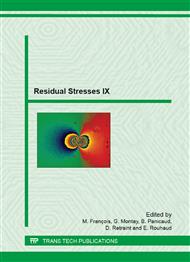p.512
p.518
p.525
p.532
p.538
p.544
p.550
p.556
p.562
Residual Stress Distribution Caused by Laser Hardening and Conventional Quenching in Plain Carbon Steel
Abstract:
Heat transfer during laser hardening occurs from the surface towards the bulk in contrast to conventional quenching, where it occurs from the bulk towards the surrounding. The residual stress distributions due to laser hardening and conventional quenching of plain carbon steel samples were measured using X-ray diffraction. The effect of changing the treatment parameters, that is laser power and feed rate, was examined on the resulting stress distribution. The relationship between the measured stress distribution and the evolved microstructure is established.
Info:
Periodical:
Pages:
538-543
Citation:
Online since:
August 2014
Authors:
Permissions:
Share:
Citation:


